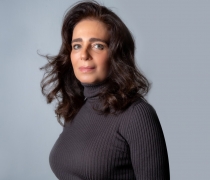Female
Born in: Nice (France) on 20, 1964.
Currently living: Sao Paulo (Brazil).
Activity:
BIO
Sonia Dias de Souza was born in Nice (France) in1964. She currently lives and works in São Paulo (Brazil). She majored in law at Universidade de São Paulo and for years she worked with constitutional and tax law. Meanwhile, she has always been interested in studies about archeology, art history and photography, which, together with the creation of objects from different materials, have always accompanied her as an expression of her imagination.
About ten years ago, Souza decided to dedicate her time exclusively to the plastic construction of her imagery and so she went on to study at the Brazilian art school Escola Panamericana de Artes. There she met Elcio Onhuma and Gisele Martini who became her friends and partners in many of the images she created. However, it was only in 2015 that she decided to show her work to the public, having been influenced and encouraged by Cláudio Edginger. In India, where he was heading a group of students in January of that same year, Edginger helped her in the decision to experience the exteriorization of her images for the world to see.
Since then, Souza has taken several independent seasonal theory courses and participated in continuous study groups about image and contemporary art under the leadership of Carlos Fajardo and Fabiana Bruno. She is also part of a study group about advanced photography with Eder Chiodetto.
One of the artist’s main research focus was developed around her restlessness regarding the mysteries of our existence and the bonds that connect us through latent memories in our subconscious, be it individual or collective. These questions are present in the images, offered as a place of pondering and contact with the observer.
Her poetry consists of touching these memories and ancestral knowledge by activating the archetypes present in the universal imagination. The compositions do not follow a rationale but are the fruit of intuitive processes from a conscious immersion in the deep and silent dimensions of one’s being. Among so many layers, they are always waiting to reveal themselves and thus become plastic material when they reach the outside world. It is during this course that they cease to be one’s memory and become visible to serve as echoes of someone else’s memories.
To develop this process, Souza uses organic materials found in nature in an attempt to approach the shapes and structures in their interior.
Her use of nude subjects is always neutral and universal. The subjects are naturally positioned with their backs to the viewer, which follows a technique that takes us back to antiquity, and which allows the observer to identify with the figure seen from behind in the foreground, and then recreate the space to be transmitted (Caspar Friedrich David, 1774-1840).
This same theme, although expressed differently, permeates the works Souza develops in the abstraction field. She researches and investigates one of the most distressing questions of humankind: understanding infinity and one’s own finitude. To that end, the artist uses familiar symbols and concepts to encourage the observer to imagine the space where they live beyond its physical dimension. That serves as a means to enable the process of exchanges and connections, where there is fertile ground for a transformative critical look that can change how we think and view the world.
The artist is always inviting us to explore self-knowledge and self-reflection from a place where the images are merely a starting point. In the era of technical reproducibility, Souza believes in the important role photography has as an instrument of reflection and intellectual activity and sees photography as a tool that encourages critical thinking and reflection in a different way than other forms of imaging do. Although photographs are “fixed”, they paradoxically have the power to offer an uninterrupted process and an unstable space to various possibilities of thought (estrangement and familiarity with what they reveal and conceal).
Souza sees that historically established matters can be questioned and understood under a new look for each historic context. The artist seeks to depict the contemporary urgency of such matters that are paramount to our future and so tightly interwoven with it. The efficacy of our actions can be influenced by the transforming power of our interior. Despite the existing avalanche of images seemingly proving the opposite, Souza believes in the fruitful power some images have to make a difference and influence our attitude towards the world. They are living, as is the river – Heraclitus – and their efficacy will change according to the historic context in which we live. But it will always be that image.
